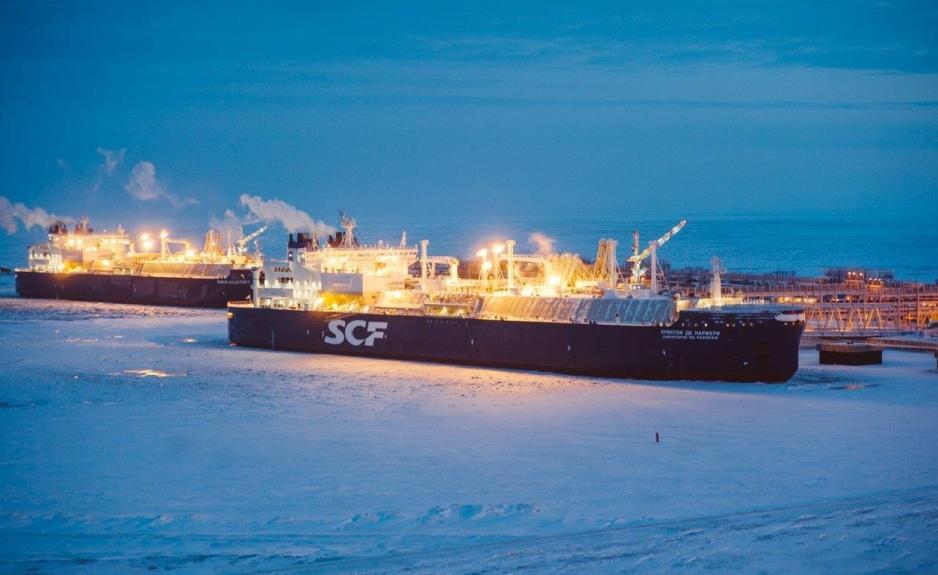New Lifecycle Assessment for Greenhouse Gases from LNG Spells Bad News for Emissions from Arctic Projects

Arc7 LNG carriers loading LNG at Sabetta in the Russian Arctic. (Source: Novatek)
Liquefied natural gas may not be as clean as previously thought, a new study finds. While liquefied gas is often heralded as a less dirty alternative to coal, its lifetime emissions exceed those from coal, the new data suggest. The report gives special emphasis to methane emissions from the transport of liquefied natural gas, a finding relevant to Arctic LNG projects.
A new study on the full lifecycle of greenhouse gasses from liquefied natural gas (LNG) projects concludes that emissions from the production and transport of LNG exceed those from coal. Methane emitted during the transport of LNG, in particular, contributes to the emissions total.
Methane is a powerful greenhouse gas around 80 times more potent than carbon dioxide – a key topic at the COP28 climate conference this week – though it is much shorter-lived.
Modern LNG tankers are able to use the LNG they carry to power their engines but the combustion of the LNG to drive the ship’s propellers results in varying degrees of methane emissions. In addition some of the transported LNG boils off as it warms during the voyage, though modern vessels are able to recapture any boil off and use it as fuel.
“In all of the scenarios considered, across all types of tankers used to transport LNG, methane emissions exceed emissions of carbon dioxide from the final combustion of LNG,” the study’s author Robert Howarth of Cornell University states.
While the assessment looks specifically at the flourishing LNG sector in the United States, its conclusions apply to Russia’s Arctic projects as well, the report’s author confirms.
“The critical variable here is time at sea, distance traveled and fuel consumption. You are correct that longer voyages will emit both more CO2 and more methane while at sea,” explains Howarth to HNN.
“Assuming these are well run, [Russia’s] Arc7 LNG carriers’ methane emissions while at sea would be largely from the ‘slippage’ that results from some methane not being burned but rather emitted in the exhaust stream. And since more LNG is consumed [during the voyage], the ‘upstream’ emissions from the production, processing, storage, and pipeline transmission of the gas will also be greater,” Howarth continued.
Methane emissions are higher
In contrast to LNG carriers transporting gas from the US to Europe across the Atlantic, Russia’s fleet of ice-breaking LNG tankers travels through ice-covered waters for large parts of the year.
The additional friction resulting from breaking through sea ice increases fuel consumption for Arctic LNG carriers, resulting in higher methane emissions.
While exact figures depend on ice conditions, studies on fuel consumption for ships traveling through sea ice indicate fuel use for Arctic LNG carriers could be as high as double compared to similar vessels in temperate waters.
In a recent study the Hamburg Ship Model Basin, a research consultancy to the worldwide maritime industry, calculated fuel consumption for an LNG tanker traveling along Russia’s Northern Sea Route (NSR).It compared a voyage in ice-free conditions during September to a trip in ice-covered waters during November and estimated an 88 percent increase in fuel use.
The vessels will consume more fuel when traveling along the Northern Sea Route.
“Due to the presence of sea ice, leading to a higher resistance, the vessels will consume more fuel when traveling along NSR. The increase in fuel consumption can be explained by more severe ice conditions that cannot be compensated by a shorter distance of the northern routes,” the experts at the Hamburg facility explain.
“The fuel consumption of vessels navigating in ice-covered waters depends, in addition to the sea ice conditions, on the vessel type and its ice-breaking capability,” the analysts conclude.
For a route from Yamal LNG to China, the ice-covered section of the NSR – where fuel consumption is elevated – could account for up to half of the total voyage distance.
More LNG, more emissions
Russia stands to double its Arctic LNG capacity in the coming two years with the opening of Arctic LNG 2 expected to be just weeks away. Additional projects, such as Murmansk LNG, are also in the works.
All LNG produced in the Arctic is transported via LNG carriers, increasingly along the eastern sections of the NSR where the most challenging ice conditions are found.
Thus, the original issue of undercounting methane emissions when transporting LNG on tankers highlighted in Howarth’s study stands to gain increasing importance for the Arctic region in the coming years.




